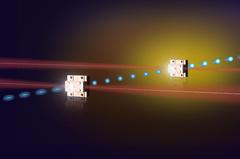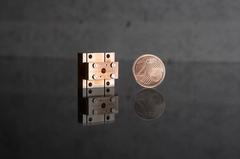URL: https://www.desy.de/news/news_search/index_eng.html
Breadcrumb Navigation
DESY News: Experimental mini-accelerator achieves record energy
News
News from the DESY research centre
Experimental mini-accelerator achieves record energy
Scientists at DESY have achieved a new world record for an experimental type of miniature particle accelerator: For the first time, a terahertz powered accelerator more than doubled the energy of the injected electrons. At the same time, the setup significantly improved the electron beam quality compared to earlier experiments with the technique, as Dongfang Zhang and his colleagues from the Center for Free-Electron Laser Science (CFEL) at DESY report in the journal Optica. “We have achieved the best beam parameters yet for terahertz accelerators,” said Zhang.

The two-stage miniature accelerator is operated with terahertz radiation (shown here in red). In a first step (left) the electron bunches (shown in blue) are compressed, in a second step (right) they are accelerated. The two individual elements are each about two centimetres wide. Credit: DESY, Gesine Born
Since terahertz waves oscillate so fast, every component and every step has to be precisely synchronized. “For instance, to achieve the best energy gain, the electrons have to hit the terahertz field exactly during its accelerating half cycle,” explained Zhang. In accelerators, particles usually do not fly in a continuous beam, but are packed in bunches. Because of the fast-changing field, in terahertz accelerators these bunches have to be very short to ensure even acceleration conditions along the bunch.
“In previous experiments the electron bunches were too long”, said Zhang. “Since the terahertz field oscillates so quickly, some of the electrons in the bunch were accelerated, while others were even slowed down. So, in total there was just a moderate average energy gain, and, what is more important, a wide energy spread, resulting in what we call poor beam quality.” To make things worse, this effect strongly increased the emittance, a measure for how well a particle beam is bundled transversally. The tighter, the better – the smaller the emittance.

STEAM is a kind of Swiss army knife for electron beams - depending on the operating mode it combines four functions in one device and can compress, focus, analyse and accelerate electron bunches. Credit: DESY, Gesine Born
The net energy gain of the electrons that were injected with an energy of 55 kiloelectron volts (keV) was 70 keV. “This is the first energy boost greater than 100 percent in a terahertz powered accelerator,” emphasised Zhang. The coupled device produced an accelerating field with a peak strength of 200 million Volts per metre (MV/m) – close to state-of-the-art strongest conventional accelerators. For practical applications this still has to be significantly improved. “Our work shows that even a more than three times stronger compression of the electron bunches is possible. Together with a higher terahertz energy, acceleration gradients in the regime of gigavolts per metre seem feasible,” summarized Zhang. “The terahertz concept thus appears increasingly promising as a realistic option for the design of compact electron accelerators.”
The achieved progress is also central for the ERC funded project AXSIS (frontiers in Attosecond X-ray Science: Imaging and Spectroscopy) at CFEL, which pursues short pulse X-ray spectroscopy and imaging of complex biophysical processes, where the short X-ray pulses are generated with THz based electron accelerators. CFEL is a joint venture of DESY, the University of Hamburg and the Max Planck Society.
Reference:
Femtosecond phase control in high field Terahertz driven ultrafast electron sources; Dongfang Zhang, Arya Fallahi, Michael Hemmer, Hong Ye, Moein Fakhari, Yi Hua, Huseyin Cankaya, Anne-Laure Calendron, Luis E. Zapata, Nicholas H. Matlis, Franz X. Kärtner; Optica, 2019; DOI: 10.1364/OPTICA.6.000872



